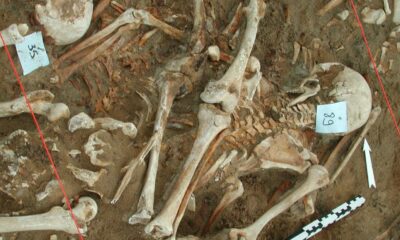Lifestyle
Ancient DNA Reveals Diseases That Devastated Napoleon’s Army

A recent study examining ancient DNA has identified additional diseases that contributed to the demise of Napoleon Bonaparte’s troops during the disastrous 1812 Russian campaign. While historical accounts have primarily attributed the high mortality rate to typhus, the new research reveals evidence of two other significant illnesses: paratyphoid fever and relapsing fever.
In the summer of 1812, Napoleon led an army of approximately 500,000 soldiers into Russia. The Russian forces employed scorched-earth tactics during their retreat, leaving Napoleon’s troops to occupy a devastated Moscow. By autumn, many soldiers began to retreat to encampments along the Russian border. An estimated 300,000 soldiers succumbed not to enemy combat but to illness exacerbated by harsh winter conditions, starvation, and exhaustion.
Researchers from Institut Pasteur analyzed bacterial DNA preserved in the teeth of 13 soldiers from a mass grave discovered in Vilnius, Lithuania, in 2001. The findings, published in the journal Current Biology, included fragments of DNA from Salmonella enterica, the bacterium responsible for paratyphoid fever, and Borrelia recurrentis, which causes relapsing fever transmitted by lice. This study enhances the historical narrative surrounding one of the most catastrophic military campaigns in history.
Stephan Talty, author of *The Illustrious Dead: The Terrifying Story of How Typhus Killed Napoleon’s Greatest Army*, commented on the implications of these findings. He noted that although typhus has often been portrayed as the primary cause of death, the evidence suggests that multiple infections impacted the troops’ health.
“Though the sample size is small, the new evidence makes a strong case that there were other infections at work,” Talty stated. “It’s not really surprising that such a large army, covering so much ground in such terrible conditions, would suffer from other illnesses.”
The mass grave, containing the remains of over 3,000 soldiers, revealed the grim realities of their hastily arranged burial. Excavations showed that human remains were often intermingled with horse skeletons, indicating a chaotic burial process during desperate times. Research conducted in 2004 suggested the intense cold had preserved the bodies in their final positions, with many buried still wearing their boots.
Previous efforts to confirm the presence of typhus in Napoleon’s army have yielded positive results, with scientists identifying DNA from the typhus-causing bacteria Rickettsia prowazekii and Bartonella quintana, responsible for trench fever. In this new study, lead researchers Remi Barbieri and Nicolas Rascovan returned to earlier samples to utilize modern gene-sequencing techniques, which allowed them to uncover a broader range of microbial DNA.
The researchers adopted an unbiased approach by sequencing all DNA fragments found in the teeth, enabling them to match these with a comprehensive database of known microbes. “It does definitely give you a sense of how much the field has changed,” noted Anne Stone, an anthropological geneticist at Arizona State University who was not involved in the study.
The study identified traces of Salmonella enterica, which can lead to gastrointestinal symptoms and fever, and hints of Borrelia recurrentis. While these diseases may not be life-threatening in modern contexts, they would have posed significant risks to Napoleon’s beleaguered army.
Barbieri and Rascovan emphasized that their findings do not diminish the role of typhus. Rather, they suggest that other illnesses also contributed to the tragic toll. Historical accounts have documented gastrointestinal distress, which could have stemmed from contaminated food sources. One report from army physician J.R.L. de Kirckhoff in 1812 highlighted soldiers suffering from diarrhea after consuming salted beets, which were likely tainted.
The advancement of microbial genetics has provided scientists with valuable insights into the evolution of diseases. In this case, the results offer a poignant glimpse into the dire circumstances faced by Napoleon’s troops, further illustrating the challenges of conducting military operations without modern amenities.
Talty summarized the significance of this research: “This new study reinforces how impossible the whole enterprise was; in a time before railroads and antibiotics, the invasion was doomed before it even began.” The exploration of ancient pathogens not only enriches our understanding of historical events but also underscores the profound impact of disease on human endeavors throughout history.
-

 Sports2 months ago
Sports2 months agoNetball New Zealand Stands Down Dame Noeline Taurua for Series
-

 Entertainment2 months ago
Entertainment2 months agoTributes Pour In for Lachlan Rofe, Reality Star, Dead at 47
-

 Entertainment2 weeks ago
Entertainment2 weeks agoNew ‘Maverick’ Chaser Joins Beat the Chasers Season Finale
-

 Sports2 months ago
Sports2 months agoSilver Ferns Legend Laura Langman Criticizes Team’s Attitude
-

 Politics3 weeks ago
Politics3 weeks agoNetball NZ Calls for Respect Amid Dame Taurua’s Standoff
-

 Entertainment2 months ago
Entertainment2 months agoKhloe Kardashian Embraces Innovative Stem Cell Therapy in Mexico
-

 Sports2 months ago
Sports2 months agoGaël Monfils Set to Defend ASB Classic Title in January 2026
-

 World3 months ago
World3 months agoPolice Arrest Multiple Individuals During Funeral for Zain Taikato-Fox
-

 Entertainment4 weeks ago
Entertainment4 weeks agoTyson Fury’s Daughter Venezuela Gets Engaged at Birthday Bash
-

 Sports4 weeks ago
Sports4 weeks agoHeather McMahan Steps Down as Ryder Cup Host After Controversy
-

 Entertainment4 weeks ago
Entertainment4 weeks agoTyson Fury’s Daughter Venezuela Gets Engaged at Birthday Bash
-

 World4 weeks ago
World4 weeks agoNew Zealand Firefighters Plan Strike on October 17 Over Pay Disputes




















